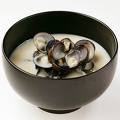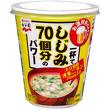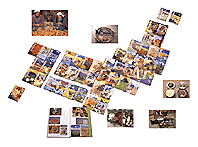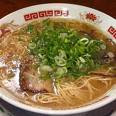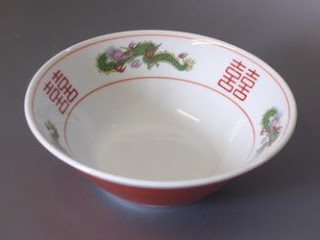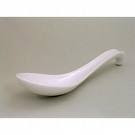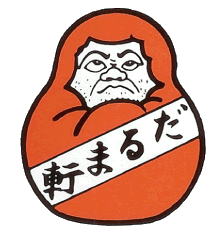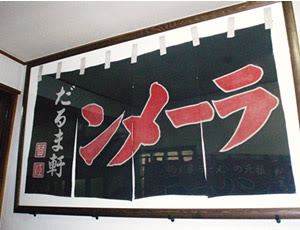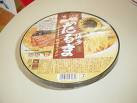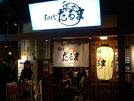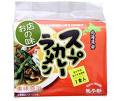::::::::::::::::::::::::::::::::::::::::::::::::::::::::::::::::::::::::::::::::::::::::::::::::::::
Sushi 寿司 すし 寿し

ー source : 浮世絵ヒーローズ -
***** Location: Japan
***** Season: All summer
***** Category: Humanity
*****************************
Explanation
Sushi is one of the well-known dishes of Japan, with many worldwide variations as it conquers the world. In sequence with other words is is often pronounced ...zushi .
Sushi-rice is usually marinated with vinegar, salt and sugar.
sushi is counted in KAN カン /貫
one portion in Edo was 5 nigiri KAN und two gunkanmaki
. 江戸生まれの握りずし First Nigiri Sushi in Edo .
:::::::::::::::::::::::::::::::::::::::::::::::::::::::::::::::::::::::::::::::::::::::::::::::::::::
November 1, Sushi Day
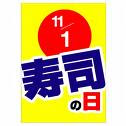
11月1日は 寿司の日
:::::::::::::::::::::::::::::::::::::::::::::::::::::::::::::::::::::::::::::::::::::::::::::::::::::
. ayuzushi 鮎鮨(あゆずし)trout sushi
kigo for all summer
. kohadazushi 小鰭鮨(こはだずし) Kohada sushi
kigo for all autumn
another name for kohada is shinkoo コハダ - しんこう
This was a favorite for Edomae Sushi.
It has to be prepared very quickly, because it spoils soon. The fish is cut, salted, washed, put in vinegar, washed again and next morning used for nigiri sushi.
. . . CLICK here for Photos !
dried kohada is sold in vacuum packs.
出世魚(こはだ)の天日干し
:::::::::::::::::::::::::::::::::::::::::::::::::::::::::::::::::::::::::::::::::::::::::::::::::::::::

source : facebook
o-nigiri for summer
:::::::::::::::::::::::::::::::::::::::::::::::::::::::::::::::::::::::::::::::::::::::::::::::::::::::
Different types of sushi
Chirashizushi (ちらし寿司, lit. scattered sushi)
Edomae chirashizushi (Edo-style scattered sushi)
Funazushi (鮒寿司) narezushi with crucian carp
Futomaki (太巻き, lit. large or fat rolls)
... one sub-species are the emaki sushi rolls 絵巻すし, with beautiful patterns when cut.
They were prepared in mountain regions, where the nori were hard to get by and had to be used sparingly. The outside wrapper would often be a thin omelett.
. . . CLICK here for Photos !
Gomokuzushi (Kansai-style chirashi sushi)
Gunkan-maki (軍艦巻, lit. warship roll)
Hosomaki (細巻き, lit. thin rolls)
Kappamaki, (河童巻き)cucumber rolls
Kokerazushi (こけらずし) square pressed sushi
Kokerazushi こけら寿司 / 柿寿司 / こけら鮨 layered sushi from Okayama
Makizushi (巻き寿司, lit. rolled sushi)
Narezushi (熟れ寿司, lit. matured sushi) fermented style
Negitoromaki (ねぎとろ巻) with scallion and chopped tuna
Nigiri-zushi (握り寿司, lit. hand-formed sushi)
Oshizushi (押し寿司, lit. pressed sushi)
Oomurazushi , Omurazushi 大村寿司
Temarizushi てまりずし, lit. ball sushi
Tekkamaki (鉄火巻き) raw tuna rolls
Uramaki (裏巻き, lit. inside-out rolls)
Zako-sushi 雑魚鮨 sushi from small fish
The Omura-Zushi 大村寿司 (oomura zushi) is a small cube of vinager-rice with fish pieces, dry mushrooms, thin egg and vegetable strips. Initially, when eating at the honour table, the warriors cut these cubes with their swords.
source : Omura flavours : www.city.omura.nagasaki.jp
. . . CLICK here for Photos !
Tosa no Inakazushi 土佐の田舎寿司
sushi from the countryside of Tosa, Shikoku
. . . CLICK here for Photos !
Sushi aus ländlichen Gebieten von Tosa, Shikoku
One includes a Ryoma Sushi. But there are others, for example in Kyoto, where he lived with O-Ryo
Ryooma Sushi, Ryoma Sushi 竜馬寿司
in memory of Sakamoto Ryoma
Made in Fushimi, Kyoto
CLICK here for PHOTOS !
Izushi 飯寿司, Summer Food (iizushi いいずし)。
made from hatahata ハタハタ and other fish fermented with cooked rice.
When Natsume Soseki came to visit Masaoka Shiki in Matsuyma in 1892, Takahama Kyoshi was also there, and Shiki's mother Yae prepared this famous local dish for them:
. Matsuyama Sushi 松山鮓 and Haiku
:::::::::::::::::::::::::::::::::::::::::::::::::::::::::::::::::::::::::::::::::::::::::::::::::::::
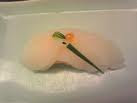
saiku sushi 細工寿司 decoration sushi
Click here for PHOTOS
Some ways to decorate sushi on a tray
nagashimori, nagashi-mori 流し盛り one beside the other, in a "flowing" arrangement
. . . CLICK here for Photos !
ichimonji 一文字 "in one line, like the character for 一 ONE"
itamori, ita mori 板盛りon a wooden plate
kasanemori, kasane-mori 重ね盛り same types on top of each other, heaped up
jiromori, jiro-mori 城盛り "stacked like a castle tower"
tawaramori, tawara-mori 俵盛り "stacked like tawara rice bales" for round cut sushi rolls
kakemori, kake-mori かけもり popped up against each other

hooshamori, hoosha-mori 放射盛り like a star, from a center to the outsice, like a mandala or pinwheel (hoshamori,hosha-mori)
Strahlenförmige Anordnung
WASHOKU : Mandala Food Arrangements
mizuhikimori, mizuhiki-mori 水引盛り one side red, the other white
like a mizuhiki
sansuimori, sansui-mori 山水盛り "Like a chinese landscape painting with mountains and water"
sansui nagashimori 山水流し盛り
. . . CLICK here for Photos !
. Mizuhiki 水引 ceremonial paper strings .
chanchiki ちゃんちき/ チャンチキ
"looks like the batchi hammer for musical intsruments"
two pieces like hammers
Sukeroku sushi 助六寿司 Sukeroku Sushi
Sukeroku is the name of a hero of the Edo period and famous Kabuki play. His beloved was the courtesan "Agemaki", so this sushi contains a some agesushi (inari sushi) and some makisushi.
. . . CLICK here for Photos !
. Specialities of Edo / Tokyo
:::::::::::::::::::::::::::::::::::::::::::::::::::::::::::::::::::::::::::::::::::::::::::::::::::::

source :www.mizkan.co.jp
Eating Edomae sushi
Utagawa Toyokuni歌川豊国
- quote -
Edomae Sushi (Edomaezushi) 江戸前寿司
The sushi commonly known around the world today is a combination of fresh raw fish, and cooked rice which is seasoned with vinegar. However, this is only a single variation within many other types of sushi that exist in Japan. This particular type of sushi is a rather modern Japanese cuisine initially created by the Edo (old name for Tokyo) fast food businesses during the 1820’s. The Edomae sushi, or Edomeaezushi directly translates to "Edo front", and literally translates to Edo style.
The Edo style sushi was a product of the booming Edo culture when more and more commoners were allowed to hold businesses of their own. Other famous fast foods dating back to the Edo period (1603- 1868) are edomae tempura, edomae soba, and edomae unagi. The Edo people were known for their busy lifestyle and lack of patience so therefore many fast food businesses became successful. Edo style cuisine are known to be saltier and sweeter compared to other cuisines in Japan.
As with other types of sushi, the Edo style sushi had a lot of unique characteristics that were eventually replaced by newer ideas and methods over the next two centuries. As refrigeration technology improved, the Edo style sushi no longer became a local specialty for a city close to fishing harbors (such as Edo), and expanded to other regions of Japan, and eventually overseas. Initially, all the neta or the main ingredients were local to the Tokyo bay, such as tuna, bonito, halibut, sea eel, and shellfish; hence the name Edomae was given to this style of sushi. Although sashimi, or raw fish was consumed in Japan for centuries, it was the first time it was combined into one entity with Japan's major staple, rice. In the early days, there faced many obstacles in how to sell Edo style sushi on the streets, since raw fish spoils quickly, and it was only consumed immediately after the fish was caught.
Since the sushi were prepared and sold on the streets by stands when there were no refrigerators at the time(and ice was expensive), sushi was required to have a long shelve life as possible(one afternoon at the most). Many of the early main ingredients were simmered in broth (sea eel, shrimp, and shellfish) with the exception of tuna, bonito, and halibut. It was vital to keep the raw texture of these fish, so they were immersed in soy sauce (zuke method) for a few hours so they can retain the raw texture while the sodium prevented the rapid spoiling. Other fish such as gizzard shad, and mackerel were cured with salt and vinegar since they had strong flavors that can withstand them. The vinegar in the sushi rice also prevented rice spoilage, but it enhanced the taste of the main ingredient as well. Though it was common, not all sashimi were consumed with wasabi. For example, in Edo, hot mustard was commonly used to eat fresh bonito sashimi, gizzard shad matched with shoga, or grated ginger, and halibut was frequently consumed with only salt or lighter variations of soy sauce and citrus. Nevertheless, wasabi was strictly used for Edo style sushi preparation because it has antibacterial properties.
The Edo style sushi continues to evolve today as older tradtions are being broken. The Edo style sushi always concentrated on focusing on the flavors of one ingredient for many years. This has changed after the fusion style sushi became popular in the United States, and eventually to the rest of the world. Many ingredients are mixed and blended to create new flavors in fusion style sushi. In Japan, a new wave of sushi called the sosaku sushi, or "creative sushi" is becomming popular. Creative sushi still tries to focus on one ingredient, but sometimes uses a second ingredient (which is usually foreign to Japanese cuisine such as caviar or foes gras) in small amounts to empahsize the main ingredient. The Edomae sushi was once thought to be a completed cuisene, however it has been proved to be borderless.
- source : - sushiencyclopedia.com/sushi

CLICK for more ukiyo-e prints!
. Food vendors in Edo - Introduction .
:::::::::::::::::::::::::::::::::::::::::::::::::::::::::::::::::::::::::::::::::::::::::::::::::::::
samegawa 鮫皮 shark's skin
is used to grate the wasabi green horseradish.
. . . CLICK here for Photos !
.............................................................................

Akazu in Edo
akazu 赤酢 red vinegar
used to mix into the shari suchi rice to make it pink.
It is made from expecially aged rice wine and is very strong. It was most popular in the Edo period and is used to our day for Edomaezushi in Tokyo.
also called
kasuzu 粕酢 ( かすず) sake lee vinegar
It was used for nigirizushi in Edo, when the fish pieces were placed on a leaf and then rice flavored with akazu rolled and pressed into it, in th yatai movable food stalls of Edo.

Akazu Today
.............................................................................
tsukeba つけば wooden plank to put the sushi on, in front of the guests.
mazemori 混ぜ盛り mixed and piled up side dishes, like grated radish
sugimori 杉盛り ginger piled up like a cedar tree
SHUN, the best season, has three parts, shun, hashiri and owari.
ootoro オオトロ comes in various parts
jabara no ootoro 蛇腹の大トロ
. . . CLICK here for Photos !
kanoko 鹿の子 "young one of a dear"
鹿子柄 "pattern like a bambi"
. . . CLICK here for Photos !
Edomae-zushi 江戸前 寿司 comes in five colors, maybe the five colors of Fudo Myo-O
goshiki sushi 五色寿司
red (maguro), white (white fish), blue (silvery fish), yellow (egg rolls), black (with nori wrapped around).
More see TOKYO.
Daruma Museum
Goshiki, 五色だるま the Five Colors
Daruma Museum
Fudo Myo-O with red eyes 目赤不動
Daruma Museum
Mizuhiki .. red and white decoration knots and cords
funamori 船盛り "sashimi on a boat", see sashimi
. . . CLICK here for Photos !
wasabi horseradish is called namida なみだ in the sushi shops, meaning "tears".
:::::::::::::::::::::::::::::::::::::::::::::::::::::::::::::::::::::::::::::::::::::::::::::::::::::::

source : www.123inspiration.com
more - - -Sushi Roll Art by Takayo Kiyota

Edvard Munch as inspiration !
:::::::::::::::::::::::::::::::::::::::::::::::::::::::::::::::::::::::::::::::::::::::::::::::::::::::
kaiten sushi, kaitenzushi 回転寿司 conveyer belt sushi
CLICK here for PHOTOS !
Sushi am Fliessband
Very popular with children. Most have regulated cheap prices for each dish with the same color or pattern.
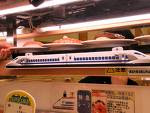
The latest is a fast lain "Shinkansen Sushi 新幹線", and even one like a monorail, where a spaceship floats in mid-air with the food on it.
::::::::::::::::::::::::::::::::::::::::::::::::::::::::::::::::::::::::::::::::::::::::::::::::::::
I have written about the famous sushi 寿司 elsewhere, below are some links of this WASHOKU SAIJIKI.
:::::::::::::::::::::::::::::::::::::::::::::::::::::::::::::::::::::::::::::::::::::::::::::::::::
Raw Fish : Sushi, sashimi, sushi and .. rice balls (onigiri)
Sushi bar, sushi restaurant
Fukusa sushi, fukusazushi ふくさずし:
"silk-square sushi"
Inari Sushi (inarizushi いなり寿司)
Takenoko sumoshi 竹の子すもし(寿司) sushi-type with bamboo sprouts and yuba wrapper.
Temple Daigoji, Kyoto
*****************************
Worldwide use
Germany
Leifheit Perfect Roll Sushi
A little contraption for one bite of sushi, to be enjoyed at parties with your friends.
. . . CLICK here for Photos !
*****************************
Things found on the way
Sushi Guide via iphone
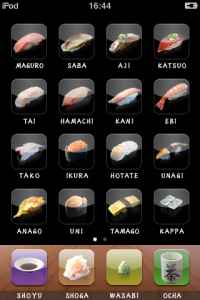
source : www.litomus.com
Learn all about traditional Japanese Sushi Menus.
On the top menu, 22 sushi are shown. Tap on a picture to get a better view.
Tap twice to get more info about the fish used.
It comes in Japanese or English.
Compatible with Apple computers.
::::::::::::::::::::::::::::::::::::::::::::::::::::::::::::::::::::::::::::::::::::::::::::::::::::
maguro nodo マグロのど throat of maguro
a bit different than kama
can be simmered or boiled or as sashimi or on a sushi (very seldom)
. . . CLICK here for Photos !
WASHOKU
maguro sushi まぐろ 寿司 sushi with tuna meat
:::::::::::::::::::::::::::::::::::::::::::::::::::::::::::::::::::::::::::::::::::::::::::::::::::::
「第1回世界すし博覧会in静岡」
First Global Sushi Exhibition
"Sushi Expo" in Shizuoka

和食からワールドフィードへ Washoku Top Event
江戸生まれの握りずし ... Nigiri Sushi born in Edo
食文化受け継ぐ郷土ずし ... Regional Sushi
旨みの引き立て役「ワサビ」に注目 ... Wasabi
地産地消の原点を今に伝える ... Shizuoka Chirashi
すしのテーマパーク「回転ずし」 ... Kaiten Sushi Conveyerbelt
やっぱり大好き!すしネタの王様マグロ ... Maguro is best
http://sushihaku.com/sushiinfo.html
:::::::::::::::::::::::::::::::::::::::::::::::::::::::::::::::::::::::::::::::::::::::::::::::::::
Daruma Sushi だるま 寿司

photo is from Orion’s photostream.
This Daruma Sushi seems to be in Helsinki.
source : http://7junipers.com/log/daruma-sushi/
There are quite a few shops in Japan called


Daruma Sushi だるま寿司
. . . CLICK here for Photos !

あさひだるま【すし】 Asahi Daruma Sushi

廻転鮨処 すしだるま Kaiten Sushi Daruma
.................................................................................

Hana O-sushi 花お寿司
source : www.edita.jp/kyaraben/archive/category10-200.html
.................................................................................

Daruma as a Sushi Chef
*****************************
HAIKU and SENRYU
次々に手から出てくるにぎり鮨
tsugitsugi ni te kara dete kuru nigirizushi
one after the other
they emerge from his hands
kneaded sushi
Kuroda Bankai 黒田逸海
:::::::::::::::::::::::::::::::::::::::::::::::::::::::::::::::::::::::::::::::::::::::::::::::::::::
屋台鮨落語のようなお茶を飲み
yataizushi rakugo no yoo na ocha on nomi
sushi from the street stall -
I drink tea
almost like in a rakugo story
Hongo Waraitei 本郷和来亭
Rakugo, comic storytelling performances
:::::::::::::::::::::::::::::::::::::::::::::::::::::::::::::::::::::::::::::::::::::::::::::::::::::
にぎり鮨いやな東京弁を聞く
nigirizushi iya na Tookyooben o kiku
hand-kneaded sushi -
I have to listen to the unpleasant
dialect of Tokyo
Ogawa Hakurai 小川百雷
::::::::::::::::::::::::::::::::::::::::::::::::::::::::::::::::::::::::::::::::::::::::::::::::::::

sushicake -
a "sweet" Christmas
far from home
Gabi Greve, 2010
Click on the image to see more sushi cake decorations.
Click for Japanese samples : 寿司ケーキ
:::::::::::::::::::::::::::::::::::::::::::::::::::::::::::::::::::::::::::::::::::::::::::::::::::::

mama says
don't play with your food ~
sushi toys
Shared by Elaine Andre
Joys of Japan
::::::::::::::::::::::::::::::::::::::::::::::::::::::::::::::::::::::::::::::::::::::::::::::::::::

Volcano Roll
sushi flambee -
my surprize at the news
of a friend
Gabi Greve
*****************************
Related words
***** WASHOKU : General Information
sushi arten
[ . BACK to DARUMA MUSEUM TOP . ]
[ . BACK to WORLDKIGO . TOP . ]
- #sushi #zushi -
:::::::::::::::::::::::::::::::::::::::::::::::::::::::::::::::::::::::::::::::::::::::::::::::::::::
